
SUMMARY
Political identity shapes how people perceive and engage with science. For scientists to communicate effectively across the political spectrum, they need to know how to adapt their approach in order to bridge divides and enhance the relevance of their communication efforts.
To help scientists in this effort, the Center for Media Engagement asked a representative sample of United States citizens about their expectations related to how scientists communicate with them. Specifically, we asked citizens about their perceptions of different communication goals, objectives, and tactics that scientists might use during their public engagement, and we measured how these perceptions vary by political ideology.
We found that liberal and conservative views align most closely on science communication that:
- Does not seek to incite anger or division
- Listens to the public and consults different viewpoints
- Discloses how research is funded
- Is not done by scientists seeking to improve their own reputation through communication
We also found that in general, liberals were more supportive of science communication goals, objectives, and tactics than conservatives, but that both liberals and conservatives were likely to describe scientists as experienced and qualified.
BACKGROUND
Public communication by scientists provides a direct link between citizens and the forefront of scientific and technological advancement. Modern communication, however, happens in a dynamic information ecosystem, where evidence is presented alongside content that centers on emotions, conspiracies, and misinformation. Simultaneously, political polarization between Republicans and Democrats is expanding,1 leading to amplified levels of distrust and worsening relations between people with differing political opinions.2 These partisan divides also extend to science3 and to specific science-related issues such as climate change.4
Together, this context highlights an increasingly urgent question: how can scientists communicate with citizens in ways that can bridge political divisions and enhance people’s ability to engage thoughtfully with scientific issues?
Addressing this question requires understanding Americans’ perceptions and expectations related to science communication. It requires exploring how Americans feel about science communicators and the ways they choose to engage. It also requires an increasingly granular assessment of what Americans prefer when it comes to the purpose and content of scientists’ communication. And, crucially, it requires exploring the extent to which Americans’ judgments about science communication are connected with their political identities.
Through a representative national survey, we sought to find out how U.S. citizens currently feel about these core aspects of science communication while taking into consideration respondents’ political ideology. Specifically, we asked respondents to make judgments about five key topics: (1) types of science communication, (2) the trustworthiness of scientists, (3) long-term communication goals, (4) short-term communication objectives, and (5) specific communication tactics.
Our focus on these five topics reflects two tenets from strategic communication research: (1) excellence theory, which highlights the importance of communication that prioritizes listening and two-way information exchange5; and (2) public relations campaign strategy, which clarifies how effective (i.e., mutually beneficial) communication stems from articulating and connecting long-term behavioral goals with short-term communication objectives and specific communication tactics.6 Science communication researchers have extensively examined these communication concepts among science communicators and those who support them,7 but little work has explored how these concepts are regarded by the public. Until this gap is addressed, communication between scientists and citizens cannot be maximized and partisan differences cannot be bridged.
KEY FINDINGS AND IMPLICATIONS
Our research identified the least polarizing science communication goals, objectives, tactics, and traits. Liberal and conservative views aligned most closely on science communication that:
- Does not seek to incite anger or division
- Listens to the public and consults different viewpoints
- Discloses how research is funded
- Is not done by scientists seeking to improve their own reputation through communication
Although liberals’ ratings were significantly higher, liberals and conservatives also shared preferences for science communication that:
- Helps people use science to make better personal decisions
- Ensures that policymakers use scientific evidence
- Informs people about scientific research
- Speaks in ways that help connect with an audience
- Is done through face-to-face interactions or via media professionals
The largest partisan differences were associated with science communication that:
- Occurs through protests or demonstrations (disliked by conservatives)
- Publicly questions the credibility of those who disagree with scientific consensus (disliked by conservatives)
- Discredits people who spread myths or incorrect scientific information (preferred by liberals)
- Seeks to secure adequate funding for scientific research (preferred by liberals)
Overall, our research shows that scientists and science communicators must consider political polarization when engaging the public. In general, liberals were more supportive of science communication goals, objectives, and tactics than conservatives, but both liberals and conservatives were likely to describe scientists as experienced and qualified.
There are signs that American citizens on both sides of the political spectrum have an appetite for a dialogue-based approach to science communication, where they can interact directly with scientists on issues that are important to them. However, the results of this survey argue against inciting anger or publicly shaming those who disagree with scientific consensus. Findings instead emphasize a preference among Americans for science communication that builds connections and encourages people to use science in their daily lives.
Scientists often believe that providing information alone is a sufficient objective for science communication. While our survey finds that people of all political leanings want informative science communication, it also shows that people of all political leanings highly value listening, openness, and talking about science in the context of society and community. Results also suggest that Americans think scientist communicators have room to grow when it comes to their warmth and relatability.
RESULTS
Opinions About Types of Science Communication
We asked survey respondents to judge the appropriateness of five different types of science communication. Overall, liberals were significantly more likely than conservatives to judge each of the five types of science communication as being appropriate. This finding could be interpreted as indicating that liberal Americans have an overall greater thirst for communication from scientists than their conservative counterparts. However, conservative respondents indicated general approval for four of the five types of science communication.
Communicating through protests and demonstrations is the type of science communication least supported by both conservatives and liberals. Generally, conservatives viewed it as being inappropriate while liberals’ overall judgment was one of lukewarm approval. This type of science communication also represents the largest gap between conservative and liberal respondents.
Liberals judged communication through media professionals as being the most appropriate mode of science communication, while conservatives’ overall most preferred mode of science communication was face-to-face communication.
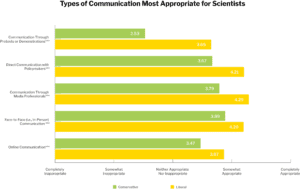
Trustworthiness of Scientists
We asked respondents to indicate their feelings about a “typical scientist” along a set of characteristics commonly used to gauge trust. Overall, we found that conservatives and liberals rated each characteristic positively. Liberals’ judgments, however, were significantly more positive than those of conservatives for all of the characteristics. This indicates a more intense multi-dimensional sense of trust in scientists among citizens who identify as liberal.
Despite this broader pattern of difference, both liberals and conservatives chose “experienced” and “qualified” as characteristics they most strongly associate with scientists. Likewise, both liberals and conservatives were relatively neutral when it came to describing scientists on a scale from “cold” to “warm.”
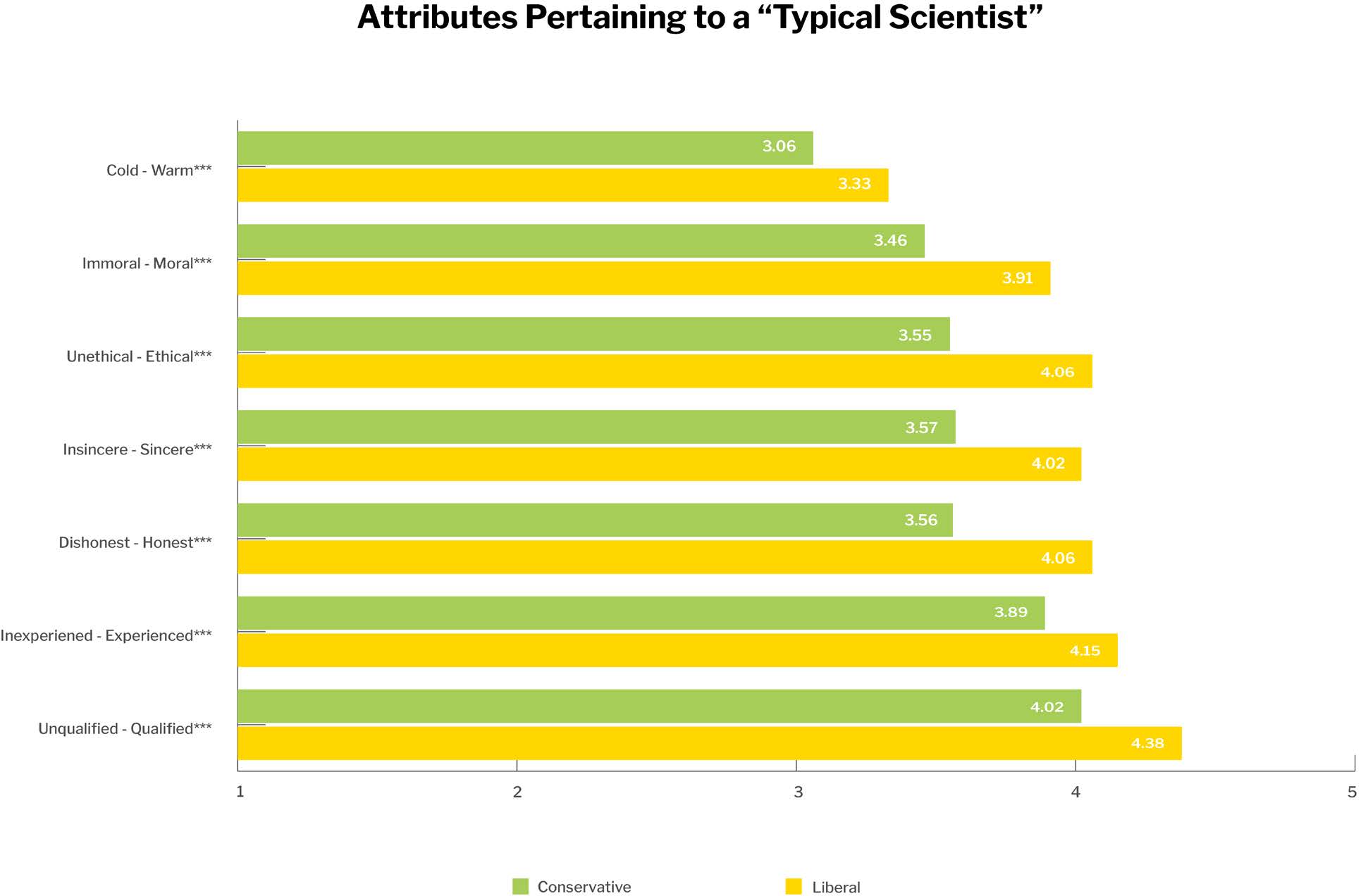
Opinions About Goals for Science Communication
We asked respondents to indicate their feelings about long-term communication goals that scientists could seek to achieve through their public engagement efforts. Overall, respondents approved of all but one communication goal regardless of their political ideology. Liberals’ approval, however, was significantly higher for all of the goals than conservatives.
Liberals most strongly approved of scientists whose engagement is motivated by a desire to “ensure that policymakers use scientific evidence,” while conservatives most strongly approved of scientists whose engagement is motivated by a desire to “help people make better personal decisions.” “Ensuring adequate funding for scientific research” was the communication goal where liberal and conservative opinions diverged most significantly.
Liberals and conservatives least approved of the same communication goal — scientists who engage to “strengthen their own professional reputation” — but liberals’ approval of this goal was still significantly higher than that of conservatives.
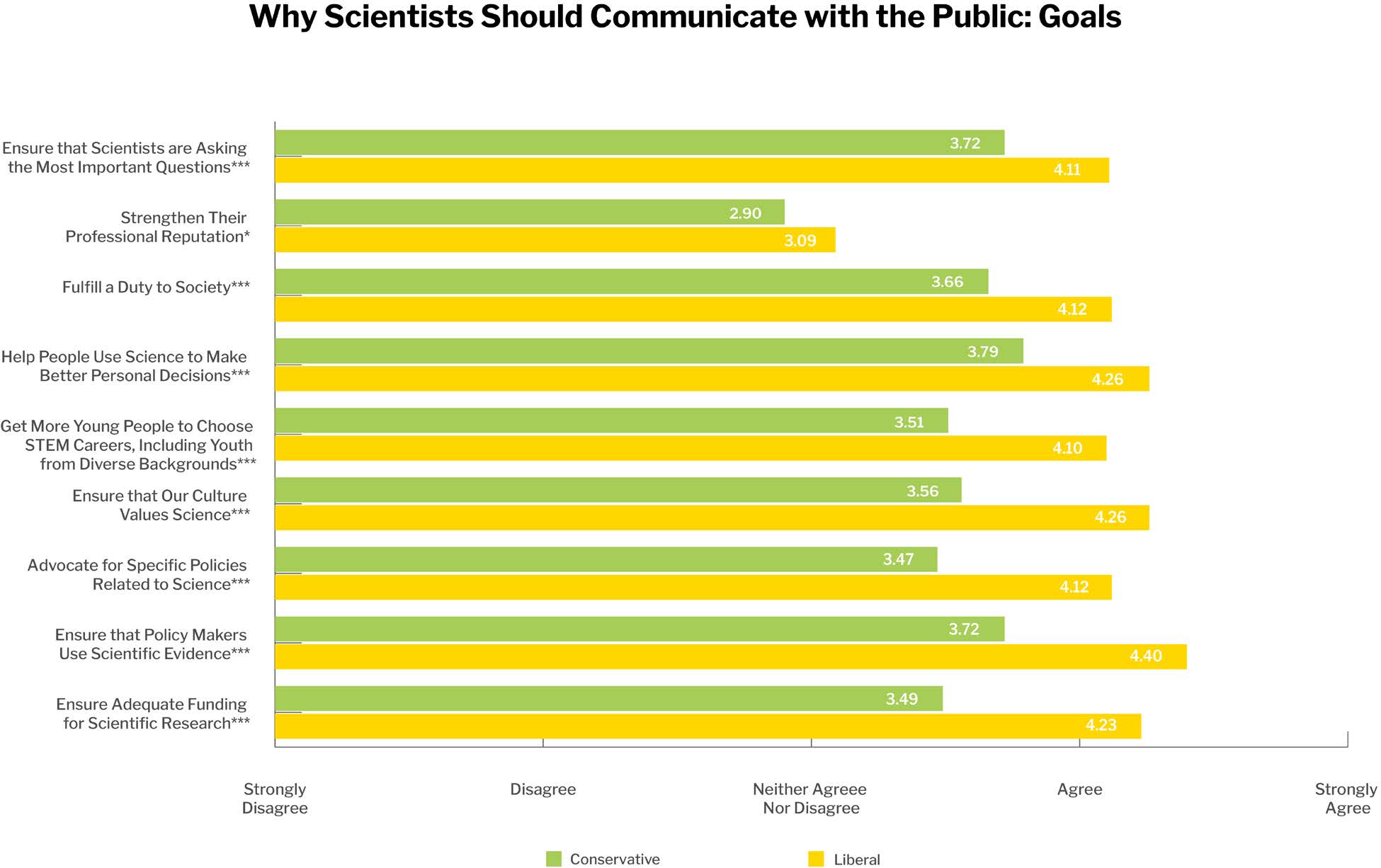
Opinions About Objectives for Science Communication
We also asked respondents to indicate their feelings about short-term communication objectives that scientists could seek to achieve through their public engagement efforts. The overall pattern of results was similar to those associated with goals; respondents generally approved of all the communication objectives. Again, however, liberals’ approval was significantly higher for all of the objectives, with average feelings for all but one objective falling being between moderate and strong agreement.
Liberals and conservatives most approved of the same communication objective — scientists who engage to “inform people about scientific research” — but liberals’ approval of this goal was still significantly higher than that of conservatives. Of all the communication objectives, liberals’ approval was weakest for engagement that is motivated to “hear what others think about scientific issues.” Conservatives’ approval for the “hear” objective was also low, but their weakest approval was for engagement that seeks to “show the scientific community’s expertise.”
“Discrediting people who spread myths or incorrect scientific information” was the communication goal where liberal and conservative opinions diverged most significantly.
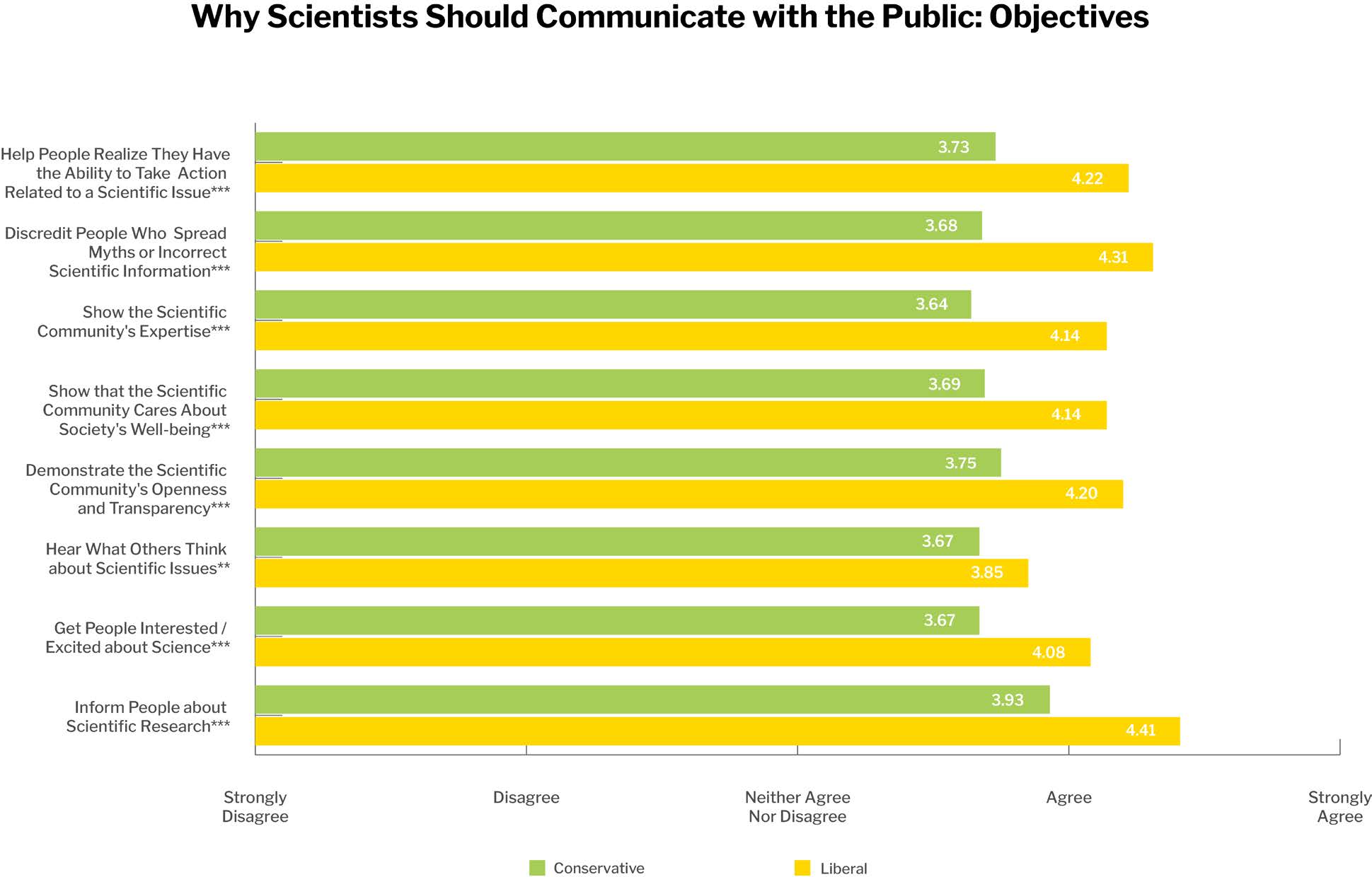
Opinions About Communication Tactics
We asked people how much they agreed or disagreed with different communication tactics that scientists could use to achieve their goals and objectives. Overall, response patterns for tactics were more varied than those associated with goals and objectives.
Regardless of political ideology, respondents did not support scientists who communicate to try and get people “angry about a scientific topic.” Conservatives also disapproved of scientists whose communication “publicly questions the credibility of those who disagree with a scientific consensus.” This tactic, however, was also the most polarizing, as liberals were significantly more likely to support it.
There was no partisan difference when it came to communication wherein scientists “disclose how their research is funded” and “ensure there are opportunities to listen to their audiences”; liberals and conservatives supported both tactics equally.
Liberal and conservative support was highest for the same tactic — “speaking in ways that help connect with an audience” — but liberals’ approval of this goal was still significantly higher than that of conservatives.
Notably, liberals and conservatives expressed only mild support of scientists whose communication “tells interesting stories”’ and “reveals personal information about their experience as a scientist.”
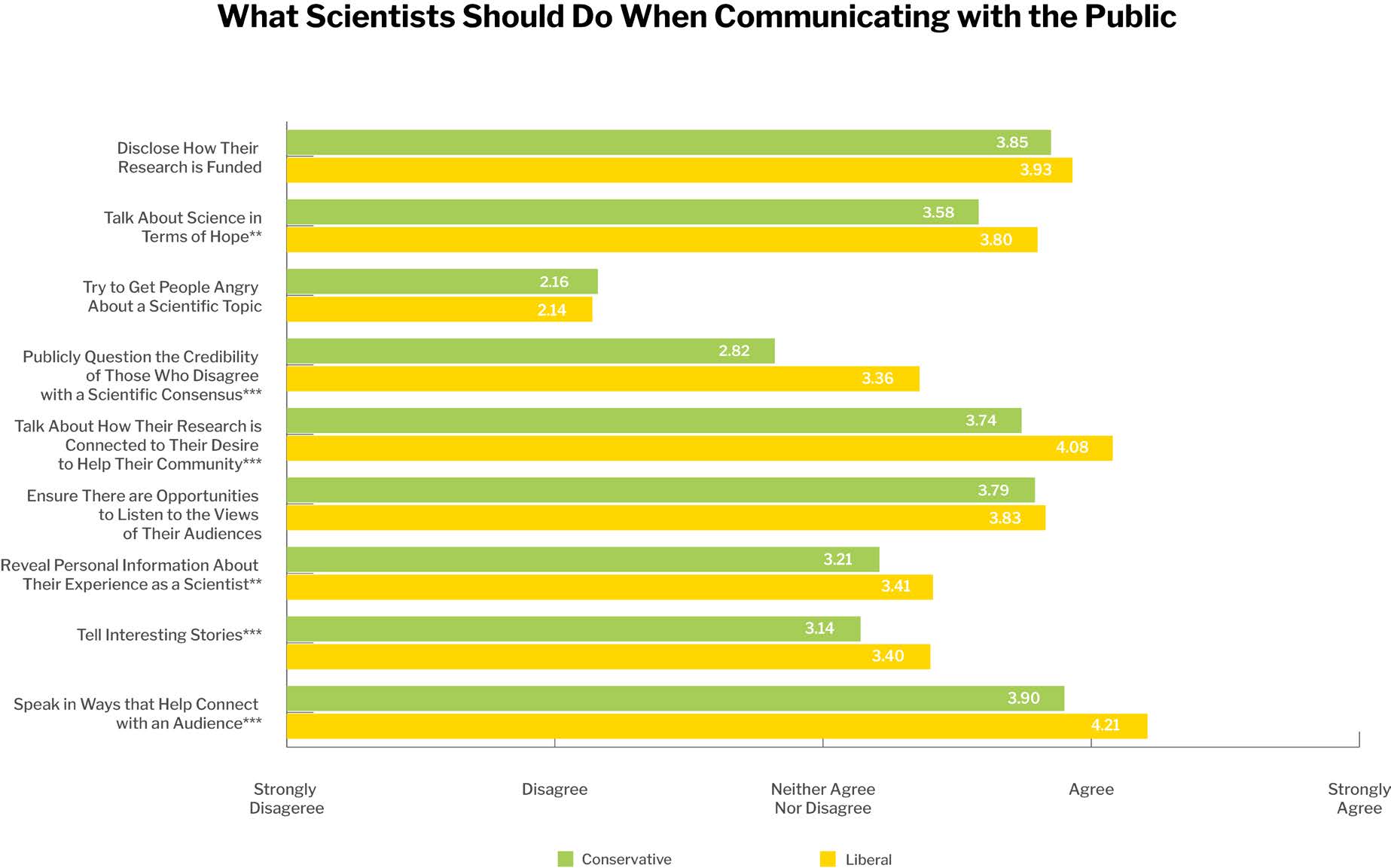
METHODOLOGY
This survey was conducted between August 4 and 17, 2020, among 1,010 Americans aged 18 and over. Survey funding was provided by the John S. and James L. Knight Foundation as part of our connective democracy initiative. Polling was conducted by NORC at the University of Chicago as part of their AmeriSpeak panel. We also thank the Rita Allen Foundation and the Fulbright US-UK Foundation for their support.
Panelists were selected using area probability and address-based sampling, and were recruited using mail, telephone, and face-to-face interviews. They were able to complete the study either online (n = 978) or via phone (n = 32). The 95% margin of error for this study, adjusted for the design effect, is +/- 4.09%. The sample is weighted for demographics (age, gender, race/ethnicity, and education) as well as Census division, housing tenure, and other aspects of the sampling design.
The sample was 53.2% female, 66.1% white, 10.1% Black, 15.4% Hispanic, 8.3% other, and represented all age groups (29.6% aged 18-29; 25.0% aged 30-44; 25.1% aged 45-59; and 20.2% aged 60 or above), education levels (22.0% high school or less, 42.7% some college, and 35.3% college degree or more), political parties (45.5% Democrats; 36.1% Republican; 17.6% Independent or other), and political ideologies (31.2% Liberals, 24.4% Moderates, 34.4% Conservatives, 10% other). Exact question wordings are listed within each graph.
Questions were all asked on a 5-point Likert scale (e.g., strongly agree to strongly disagree) or a 5-point semantic differential scale (e.g., ethical to unethical).
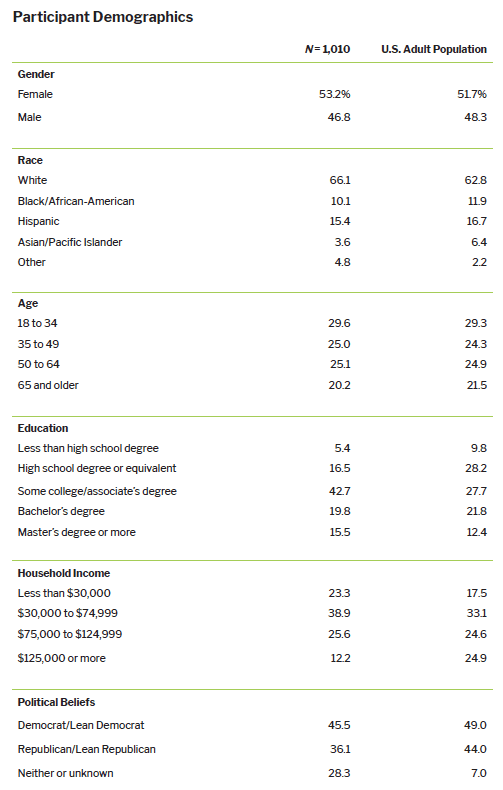
Suggested Citation
Heslop, C., Dudo, A., and Copple, J. (August, 2021). Communicating science across political divides. Center for Media Engagement. https://mediaengagement.org/research/communicating-science- across-political-divides
- Iyengar, S., Sood, G., & Lelkes, Y. (2012). Affect, not ideology: A social identity perspective on polarization. Public Opinion Quarterly, 76(3), 405–431. https://doi.org/10.1093/poq/nfs038 [↩]
- Iyengar, S., Lelkes, Y., Levendusky, M., Malhotra, N., & Westwood, S. J. (2019). The origins and consequences of affective polarization in the United States. Annual Review of Political Science, 22, 129–146. https://doi.org/10.1146/ annurev-polisci-051117-073034 [↩]
- Gauchat, G. (2012). Politicization of science in the public sphere: A study of public trust in the United States, 1974 to 2010. American Sociological Review, 77(2), 167–187. https://doi.org/10.1177/0003122412438225 [↩]
- Pew Research Center (2020). “Two-Thirds of Americans Think Government Should Do More on Climate” Retried on June 18, 2021, https://www.pewresearch.org/science/2020/06/23/two-thirds-of-americans-think-government- should-do-more-on-climate/ [↩]
- Grunig, J. E. (2001). Two-way symmetrical public relations: Past, present, and future. In R. H. Heath (Ed.), Handbook of public relations (pp. 11–30). Thousand Oaks, CA: Sage; Grunig, J. E., & Dozier, D. M. (2003). Excellent public relations and effective organizations: A study of communication management in three countries. New York, NY: Routledge; Grunig, J. E., & Hunt, T. (1984). Managing public relations (Vol. 343). New York, NY: Holt, Rinehart and Winston. [↩]
- Hon, L. C. (1998). Demonstrating effectiveness in public relations: Goals, objectives, and evaluation. Journal of Public Relations Research, 10(2), 103-135. https://doi. org/10.1207/s1532754xjprr1002_02; Kendall, R. (1996). Public relations campaigns strategies: Planning for implementation. HarperCollins. [↩]
- Besley, J. C., Dudo, A., Yuan, S., & Lawrence, F. (2018). Understanding scientists’ willingness to engage. Science Communication, 40(5), 559-590. https://doi.org/10.1177/ 1075547018786561; Besley, J. C., Newman, T. P., Dudo, A., & Tiffany, L. A. (2021). American Scientists’ Willingness to Use Different Communication Tactics. Science Communication, 10755470211011159; Dudo, A., & Besley, J. C. (2016). Scientists’ prioritization of communication objectives for public engagement. PloS one, 11(2), e0148867; Dudo, A., Besley, J. C., & Yuan, S. (2020). Science communication training in North America: Preparing whom to do what with what effect? Science Communication, 1075547020960138. [↩]



